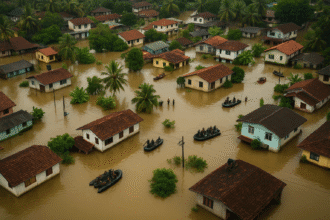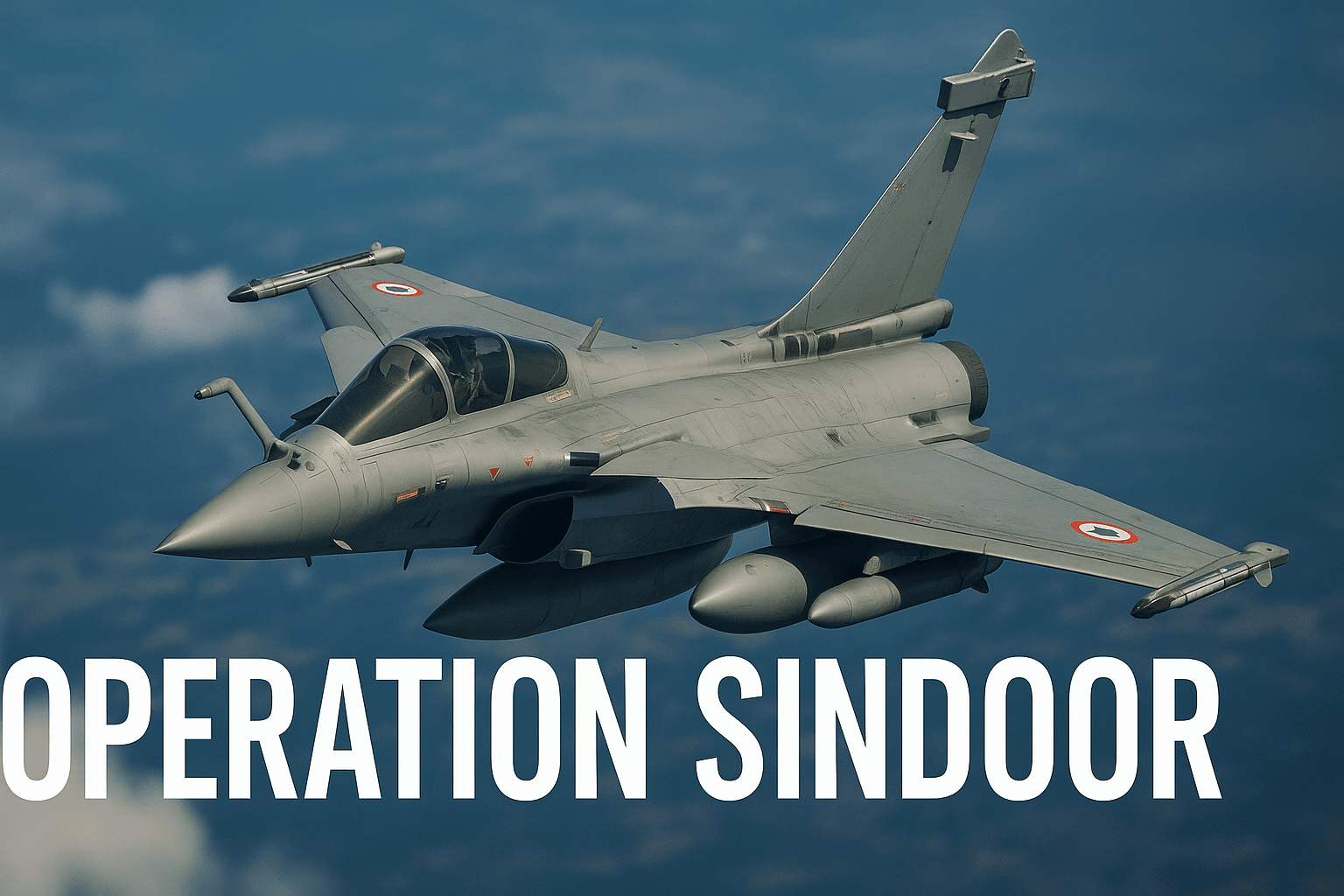The recent India Pakistan War underscores the fragile nature of peace in the region. While the situation has stabilized as of May 11, 2025, continued vigilance and diplomatic engagement are essential to prevent future conflicts.
May 7, 2025 – India Pakistan War: Precision Strikes Across PoK

In the early hours of May 7, 2025, the Indian Armed Forces launched a series of coordinated air and drone strikes targeting terror launch pads and training camps in Pakistan-occupied Kashmir (PoK). This action marked the beginning of the most intense military escalation between the two nuclear-armed neighbours since the Balakot airstrikes in 2019.
The Trigger: Pahalgam Massacre and Threat Assessment
India’s decision followed the Pahalgam terror attack on April 22, which claimed 26 civilian lives, and a steady stream of intercepted intelligence pointing to imminent terror infiltration plans across the LoC. According to Ministry of Defence sources, the targets included:
- Launch pads in Kel, Athmuqam, and Jura sectors
- Weapon storage units near Muzaffarabad
- Communication bunkers in Kotli and Bhimber
These locations were believed to house key operatives of Lashkar-e-Taiba (LeT) and Jaish-e-Mohammed (JeM), both of which are backed by Pakistan’s Inter-Services Intelligence (ISI).
Assets Used and Strike Details
India deployed:
- Rafale and Sukhoi-30 MKI jets for deep penetration precision strikes
- Armed Heron drones for aerial surveillance and real-time target validation
- Loitering munitions for single-target eliminations
Reports indicated that the strikes were executed between 3:00 AM and 3:25 AM IST, and lasted less than 30 minutes, taking out an estimated 60–70 militants and infrastructure. Thermal imaging confirmed direct hits without any spillover into civilian areas.
India’s Official Statement
In a carefully worded press release, the Ministry of External Affairs (MEA) said:
“India has exercised its right to self-defense. These strikes are a direct response to Pakistan-sponsored terrorism and are designed to neutralize terror threats without escalation.”
The Ministry of Defence reiterated that all operations were planned with surgical precision, and no Pakistani civilian or military facility was targeted.
Domestic Reactions
Indian citizens hailed the move, with #IndiaStrikesBack and #OperationJustice trending across social media. Defense analysts praised the government for:
- Acting swiftly after weeks of public pressure
- Informing key global allies in advance
- Avoiding reckless escalation
The opposition parties, while expressing concern over regional stability, stood by the Armed Forces and demanded a united front.
Pakistan’s Initial Response
Pakistan’s Foreign Ministry denied that terror camps were hit, instead alleging that Indian jets had targeted civilian settlements. In an early morning press conference, a Pakistani army spokesperson claimed:
“We will not allow India’s war narrative to go unchallenged. Our sovereignty has been violated, and we reserve the right to respond.”
However, no footage or substantial evidence of civilian damage was provided by Islamabad, and independent observers were not granted access to the alleged strike zones.
May 8, 2025 – Pakistan Retaliates, India Contains: Escalation Across the Line of Control
The day following India’s May 7 strikes saw Pakistan retaliating with a series of cross-border ceasefire violations and artillery shelling across multiple sectors of the Line of Control (LoC). This marked a sharp escalation in the conflict, with active military engagement spreading across the northern and western fronts of Jammu and Kashmir.
Pakistan’s Retaliatory Moves
By mid-morning on May 8, Pakistan’s military confirmed it had “responded to Indian aggression” by launching what it termed “counter-battery fire” and drone-based surveillance operations in sectors including:
- Krishna Ghati (Poonch district)
- Keran and Gurez (Kupwara)
- Rajouri and Bhimber Gali
- Tangdhar and Uri sectors
A Pakistani ISPR (Inter-Services Public Relations) statement claimed their army had “downed two Indian surveillance drones” and “inflicted heavy damage on Indian forward posts.” However, no independent confirmation of this damage was available from neutral observers or satellite sources.
Meanwhile, Indian defence sources reported that over 18 ceasefire violations had occurred across LoC sectors by late evening. The firing included 155mm artillery shells, recoilless rifles, and sniper rounds aimed at Indian forward installations and civilian areas.
Civilian Impact and Evacuations
In Jammu and Kashmir, shelling forced the evacuation of over 1,800 civilians from border villages in Poonch and Rajouri. Casualties included:
- Two civilians injured in the Nowshera sector
- One BSF jawan reportedly sustained minor injuries in the Uri sector
Temporary shelters and underground bunkers were activated, and border schools were shut down in anticipation of further escalation.
India’s Tactical Response
Despite the provocations, India’s response was calibrated and controlled. Indian Army spokesperson Lt. Gen. Devendra Mehta stated:
“Our positions have responded effectively and proportionately. Pakistan’s attempt to internationalize the issue through escalation will not succeed. Our operations remain limited to counter-terrorism and defense.”
No offensive was launched across the LoC from the Indian side beyond retaliatory fire. The Indian Air Force remained on high alert, with radar tracking intensified across Punjab, J&K, and Rajasthan sectors.
Drones continued to fly along the LoC and IB (International Border), but Indian officials confirmed that no airspace violations into Pakistan’s mainland occurred after the May 7 strikes.
MEA and Defence Ministry Stand Firm
The Ministry of External Affairs (MEA) released a second statement reiterating that India’s May 7 operation was a one-time, targeted action against terror infrastructure, and that the ball was now in Pakistan’s court to either escalate or de-escalate.
The Ministry of Defence (MoD) maintained that Indian forces were under clear orders: no escalation unless provoked, and to focus solely on neutralizing threats within India’s sovereign territory and protecting civilian populations.
International Reactions Begin to Emerge
Several countries began reacting to the rapidly unfolding situation.
- The United States State Department called for restraint but recognized India’s “legitimate right to self-defense.”
- France and Australia issued statements supporting India’s position that terror infrastructure cannot remain untouched across borders.
- China, in a cautious tone, urged “both parties to avoid further escalation and return to dialogue.”
At this stage, the global mood was generally in India’s favor, largely due to the nature of the May 7 strike, which avoided military or civilian targets in Pakistan and was clearly linked to counter-terrorism.
May 9, 2025 – Drone Warfare, Cross-Border Shelling, and Shifting Narratives
As the conflict entered its third consecutive day, May 9 marked a critical turning point in the escalation—witnessing unprecedented use of drones, intensified cross-border shelling, and information warfare across diplomatic and media platforms.
While no new offensive was launched by India on this day, both sides engaged in tactical posturing and defensive manoeuvres, indicating that the situation was on the brink of wider conflict.
Pakistani Drone Intrusions and Indian Intercepts
Indian defence officials reported that at least five Pakistani drones were detected attempting to cross into Indian airspace in border districts of Punjab and Jammu.
- Two drones were intercepted and shot down by IAF Sukhoi-30 MKI jets using air-to-air missiles near Gurdaspur and Samba.
- A third was brought down by electronic jamming systems operated by the Indian Army’s signal intelligence units in Rajouri.
Visuals of the drone wreckage were released by Indian defence forces, clearly showing Chinese-made commercial drone parts, a point later echoed in statements by security analysts and military think tanks.
This pattern strongly indicated:
- Pakistan’s attempts to gather tactical intelligence
- Possible attempts to drop payloads near civilian or strategic targets
Indian Air Force officers noted that the frequency of drone activity was the highest recorded since the 2020 Ladakh standoff, signaling a modern warfare element in the ongoing conflict.
Artillery Duels Across the LoC
By mid-afternoon, heavy artillery exchanges resumed along the LoC in Poonch, Kupwara, and Baramulla districts.
- Over 60 rounds of 155mm artillery were exchanged in a span of 3 hours in the Krishna Ghati sector alone.
- Indian Army confirmed targeted strikes on Pakistani bunkers, after which Pakistani firing significantly reduced.
- Indian forward posts sustained minor damage, and one Army JCO was reportedly injured in the Tangdhar sector.
Despite the intensity of fire, the Indian Army maintained strict fire discipline, choosing not to escalate to deeper offensives.
Civilian Casualties and Displacement
Civilian fallout intensified on both sides of the border.
- Over 3,500 Indian civilians were moved to relief shelters in Poonch, Rajouri, and Uri.
- Several civilian homes in Balakote and Mendhar areas suffered damage due to shrapnel and shelling.
Indian authorities activated emergency relief protocols, including:
- Medical aid camps
- Mobile bunkers
- Free ration distribution under NDMA supervision
In contrast, Pakistan claimed Indian shelling caused “civilian deaths in Neelum Valley,” though this could not be independently verified, and no international media were granted access.
Pakistan’s Domestic Narrative and Claim of “Victory”
In Islamabad, the Pakistani government began amplifying a victory narrative, claiming they had:
- “Repelled India’s aggression”
- “Downed multiple Indian drones”
- “Foiled attempts to breach territorial sovereignty”
Pakistan’s Prime Minister addressed the nation, urging “unity in the face of Indian provocation” and accused New Delhi of attempting to destabilize the region.
However, these claims were met with skepticism:
- No verifiable footage was shared
- ISPR’s statements were inconsistent with independent satellite observations
- Most “victory” claims appeared aimed at domestic stability and face-saving diplomacy
Meanwhile, Indian diplomatic sources accused Pakistan of misinformation warfare, attempting to portray a defensive posture as a counter-offensive success.
MEA and MoD Reaffirm India’s Objectives
India’s Ministry of External Affairs (MEA), in a late-night media interaction, reiterated:
“India’s actions remain defensive and proportionate. Any claim of Indian airspace violations or losses is baseless. The world knows who sponsors terror and who fights it.”
The Ministry of Defence released real-time aerial imagery showing destroyed terror hideouts in PoK, refuting Pakistan’s claims of civilian damage.
This calculated move helped solidify India’s position on the global stage as a restrained yet capable actor, maintaining the moral high ground while defending its borders.
May 10, 2025 – Ceasefire Announced, Breached by Nightfall
Following three days of escalating tensions along the Line of Control (LoC), India and Pakistan agreed to a ceasefire on May 10, 2025, mediated in part by the United States and backchannel diplomacy involving the United Arab Emirates and Russia. The goal was to prevent the crisis from spiraling into a full-scale regional conflict.
However, the day that began with hope for de-escalation ended with Pakistan breaching the truce just hours after agreeing to it, through renewed shelling and drone incursions—a move that drew sharp condemnation from New Delhi.
Ceasefire Announcement and Global Diplomacy
Around 10:00 AM IST, both countries released near-simultaneous statements announcing an agreement to cease hostilities. This announcement came after urgent consultations involving:
- U.S. State Department
- National Security Advisors from both nations
- Ambassadors from the UAE, France, and Russia
The ceasefire terms included:
- Immediate halt of cross-border firing
- Suspension of drone surveillance along LoC
- No further aerial strikes from either side
- Return to pre-conflict defensive postures
In New Delhi, the Ministry of External Affairs confirmed:
“India has always advocated for peace but reserves the right to protect its sovereignty and citizens. The ceasefire is a gesture of maturity, not weakness.”
Pakistan’s Foreign Ministry released a more confrontational statement, claiming:
“Pakistan’s armed forces have delivered a befitting response to Indian aggression. The ceasefire reflects Pakistan’s commitment to peace, but not at the cost of honour.”
Ceasefire Violated by Pakistan the Same Night
By 10:45 PM IST, multiple Indian forward posts in Rajouri, Nowshera, and Tangdhar sectors came under renewed Pakistani shelling.
Simultaneously:
- Two Pakistani drones crossed into Indian airspace in Punjab’s Tarn Taran and Jammu’s Samba district.
- One drone dropped a small explosive payload near an abandoned BSF post—causing no injuries but confirming intent.
- Both drones were neutralized by India’s air defense systems and drone-jamming units.
India’s Army headquarters in Northern Command issued a formal alert and resumed localized retaliatory fire, maintaining the limited engagement rules of engagement (ROE).
India’s Strong Rebuttal
At midnight, the Indian Ministry of External Affairs issued a sharp statement:
“Despite entering into a ceasefire agreement in good faith, Pakistan has violated the terms within hours. These provocations are deliberate, reckless, and prove Pakistan’s duplicity on international platforms.”
Sources within the Indian establishment confirmed that the Indian side informed Washington and key UNSC members immediately, sharing intercepted radio chatter that proved pre-planned Pakistani action after agreeing to the truce.
The Ministry of Defence also confirmed that:
- India did not initiate any fresh attack post-ceasefire.
- Retaliatory measures remained confined to neutralizing threats near Indian border installations.
- No Indian troop movement across the LoC occurred after May 7.
China’s Subtle Alignment with Pakistan
While most global powers leaned toward India’s narrative, China’s position stood out for its strategic ambiguity.
Beijing officially stated:
“China urges both nations to respect the ceasefire and maintain regional peace. All parties must avoid further provocation.”
However, multiple geopolitical analysts and Indian officials noted key points indicating China’s tacit support for Pakistan, including:
- Diplomatic shielding – China opposed a strongly worded UNSC statement drafted by the U.S. and France that named Pakistan as a harborer of terror elements.
- Trade movements – Increased activity was observed along the China-Pakistan Economic Corridor (CPEC) routes in Balochistan and PoK during the conflict window.
- Military signals – Chinese surveillance satellites reportedly reoriented toward Northern India, according to a report by India’s DRDO intelligence units.
Though China stopped short of directly endorsing Pakistan’s military actions, its silence on the Pahalgam attack and emphasis on “both sides showing restraint” was widely viewed as a diplomatic balancing act in favor of its ally.
India’s response remained cautious, with MEA sources saying:
“We have taken note of China’s position and urge all responsible global actors to condemn terrorism in clear, unequivocal terms.”
Pakistan’s Domestic Messaging: Manufactured Victory
Inside Pakistan, the ceasefire was sold as a strategic win by government-controlled media outlets.
- Prime-time coverage showed visuals of downed drones (many of which lacked time or location stamps).
- The Pakistan Army claimed it had “defended national honor and taught India a lesson.”
- No mention was made of the loss of key terror infrastructure in the May 7 strikes or the international diplomatic pressure that led to the ceasefire.
This internal narrative management was seen as an attempt to calm domestic unrest and preserve military prestige, especially as footage and reports from global media increasingly supported India’s position.
May 11, 2025 – Return to Normalcy: De-escalation, Global Relief, and Strategic Clarity

By the morning of May 11, 2025, hostilities along the India-Pakistan border had largely ceased, with no new reports of cross-border firing, drone activity, or military escalation. After four days of high alert, tense diplomacy, and tactical maneuvering, the LoC fell quiet—signaling an end to the short but intense conflict that began with India’s May 7 strikes under Operation Sindoor.
While the night of May 10 saw Pakistan breaching the ceasefire agreement, by 4:00 AM IST on May 11, India’s Ministry of Defence confirmed that the Pakistani side had ceased firing, and drone surveillance had stopped.
Gradual De-escalation on the Ground
By mid-morning, several key developments indicated a return to stability:
- Civilian evacuations paused across Rajouri, Poonch, and Kupwara as residents began returning home.
- Border schools reopened in select districts after remaining shut for 72 hours.
- Forward Army units stood down from full combat readiness to regular patrol and surveillance status.
- IAF fighters remained on standby, but no additional sorties were launched.
The Indian Army Northern Command confirmed that all Indian responses had remained within national borders, and no fresh provocation had occurred post the early hours of May 11.
The ceasefire, although fragile, was now holding in practice, if not entirely in trust.
Diplomatic Communication and International Support
India’s MEA continued its active diplomatic engagement with world powers, updating missions and briefing strategic partners including:
- United States
- France
- United Arab Emirates
- United Kingdom
- Australia and Japan (Quad members)
In contrast to the silence after past conflicts, this time the global narrative was largely in India’s favor. Key reasons included:
- India’s transparent military objectives—targeting only known terror camps, not civilians or Pakistani military assets.
- Public release of intelligence-backed visuals of damage inflicted on camps in PoK.
- Consistent diplomatic messaging across platforms, led by Foreign Secretary Vikram Misri and Defence Minister Rajnath Singh.
The United Nations Secretary-General António Guterres released a statement:
“We welcome the return to calm along the India-Pakistan border. We encourage continued restraint and a renewed commitment to preventing future escalations.”
MEA and Defence Ministry: India’s Strategic Messaging
The Ministry of External Affairs (MEA) released a comprehensive document detailing:
- The chain of events from the Pahalgam attack
- Intelligence inputs linking Pakistan-based groups
- Targeted nature of India’s May 7 strikes
- Drone violations and the May 10 ceasefire breach
The Ministry of Defence, in a coordinated press conference with the Army and IAF, reiterated:
“India’s objective was never conflict for conflict’s sake. Our mission was deterrence through precision, and discipline under provocation. That mission has been accomplished.”
This unified message—of strength with responsibility—earned India rare international admiration for a country engaged in live border conflict.
Pakistan’s Final Statements: Damage Control and Denial
On May 11, Pakistan’s Inter-Services Public Relations (ISPR) issued a final statement claiming:
“Pakistan has ensured its territorial integrity and responded to Indian aggression in a proportionate manner. Our response and restraint both reflect our strength.”
However, Pakistan offered no proof of military success, nor did it address its violation of the May 10 ceasefire agreement. Analysts viewed these remarks as an attempt to maintain domestic political stability and prevent the perception of strategic failure.
State-backed media in Pakistan returned to covering domestic politics and Eid preparations, indicating a shift back to civilian normalcy.
India’s Strategic Takeaway: A Clear Doctrine
The events from May 7 to 11 have shaped a new clarity in India’s strategic posture:
- Terror attacks will not go unanswered, regardless of diplomatic consequences.
- Surgical, intelligence-led operations are now the default military response.
- India will strike only what threatens it, but will do so with precision and international backing.
- Restraint remains a strength, not a sign of weakness.
Conclusion: A Short Conflict, A Long Message
The Indian Air Force (IAF) on Sunday stated that Operation Sindoor — launched as a counter-offensive against the dastardly attack by Pakistan-backed terrorists in Pahalgam — is still in progress, a day after both New Delhi and Islamabad announced a ceasefire.
“Since the Operations are still ongoing, a detailed briefing will be conducted in due course. The IAF urges all to refrain from speculation and dissemination of unverified information,” the IAF declared on its official handle in X.
The India-Pakistan conflict from May 7 to May 11, 2025, though brief in duration, marked a turning point in South Asia’s security narrative. Sparked by the brutal Pahalgam terror attack, India’s precise and measured response through Operation Sindoor sent a clear message: terror will no longer be tolerated, and retaliation will be swift, strategic, and globally justified.
Across five days, the region witnessed:
- A historic airstrike campaign deep inside PoK
- The largest coordinated drone warfare episode between the two countries
- Civilian displacement, international diplomatic interventions, and media narratives spun on both sides
Yet, what stands out is not the military might, but the restraint with which India operated. Despite provocations, ceasefire violations, and aggressive posturing from Pakistan, India remained anchored to a doctrine of proportional response, anchored in lawful self-defense under Article 51 of the UN Charter.
India’s Ministry of External Affairs and Defence Ministry worked in sync—not only executing a military plan but managing the global narrative that shaped world opinion. The result: international credibility, moral high ground, and operational success.
Meanwhile, Pakistan’s attempts to shape a victory narrative at home fell flat in the face of hard evidence, drone wreckage, satellite data, and the diplomatic weight behind India’s actions.
As the guns fell silent on May 11, the broader message echoed far beyond the LoC:
- India will not strike first, but it will strike back—with precision and purpose.
- Terrorism will be treated as an act of war, not a diplomatic issue.
- Ceasefires are sacred—but if broken, consequences will follow.
The conflict also underscored new dimensions in modern warfare: drones, information warfare, satellite intelligence, and swift media shaping, all playing pivotal roles in how conflicts are fought—and perceived.
Looking Ahead
The return to calm on the morning of May 11 was not just the end of a military episode. It was the beginning of a new strategic doctrine for India—one that upholds peace, but no longer absorbs violence without consequence.






